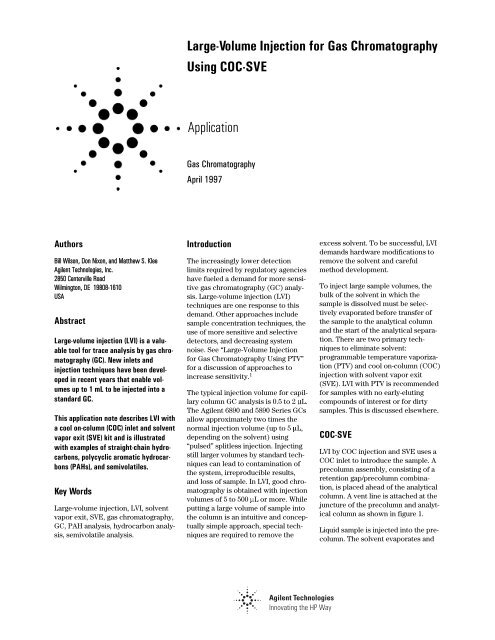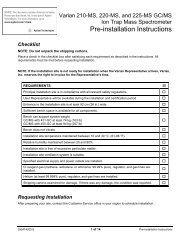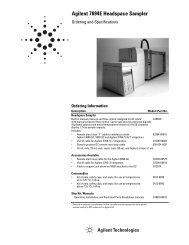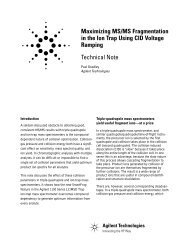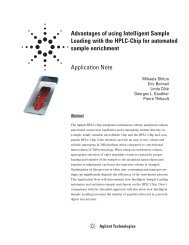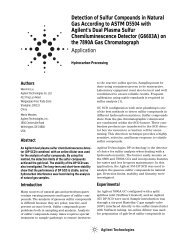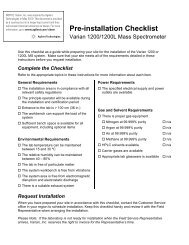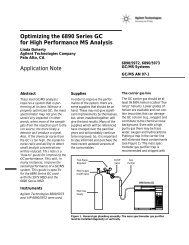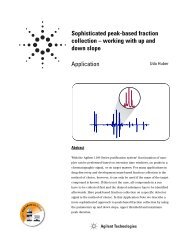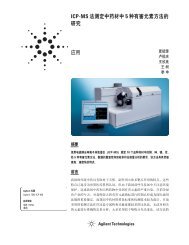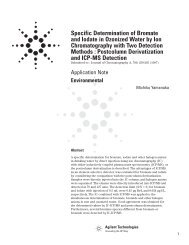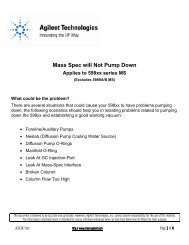Large-Volume Injection for Gas Chromatography Using COC-SVE
Large-Volume Injection for Gas Chromatography Using COC-SVE
Large-Volume Injection for Gas Chromatography Using COC-SVE
Create successful ePaper yourself
Turn your PDF publications into a flip-book with our unique Google optimized e-Paper software.
Authors<br />
Bill Wilson, Don Nixon, and Matthew S. Klee<br />
Agilent Technologies, Inc.<br />
2850 Centerville Road<br />
Wilmington, DE 19808-1610<br />
USA<br />
Abstract<br />
<strong>Large</strong>-volume injection (LVI) is a valuable<br />
tool <strong>for</strong> trace analysis by gas chromatography<br />
(GC). New inlets and<br />
injection techniques have been developed<br />
in recent years that enable volumes<br />
up to 1 mL to be injected into a<br />
standard GC.<br />
This application note describes LVI with<br />
a cool on-column (<strong>COC</strong>) inlet and solvent<br />
vapor exit (<strong>SVE</strong>) kit and is illustrated<br />
with examples of straight-chain hydrocarbons,<br />
polycyclic aromatic hydrocarbons<br />
(PAHs), and semivolatiles.<br />
Key Words<br />
<strong>Large</strong>-volume injection, LVI, solvent<br />
vapor exit, <strong>SVE</strong>, gas chromatography,<br />
GC, PAH analysis, hydrocarbon analysis,<br />
semivolatile analysis.<br />
<strong>Large</strong>-<strong>Volume</strong> <strong>Injection</strong> <strong>for</strong> <strong>Gas</strong> <strong>Chromatography</strong><br />
<strong>Using</strong> <strong>COC</strong>-<strong>SVE</strong><br />
Application<br />
<strong>Gas</strong> <strong>Chromatography</strong><br />
April 1997<br />
Introduction<br />
The increasingly lower detection<br />
limits required by regulatory agencies<br />
have fueled a demand <strong>for</strong> more sensitive<br />
gas chromatography (GC) analysis.<br />
<strong>Large</strong>-volume injection (LVI)<br />
techniques are one response to this<br />
demand. Other approaches include<br />
sample concentration techniques, the<br />
use of more sensitive and selective<br />
detectors, and decreasing system<br />
noise. See “<strong>Large</strong>-<strong>Volume</strong> <strong>Injection</strong><br />
<strong>for</strong> <strong>Gas</strong> <strong>Chromatography</strong> <strong>Using</strong> PTV”<br />
<strong>for</strong> a discussion of approaches to<br />
increase sensitivity. 1<br />
The typical injection volume <strong>for</strong> capillary<br />
column GC analysis is 0.5 to 2 �L.<br />
The Agilent 6890 and 5890 Series GCs<br />
allow approximately two times the<br />
normal injection volume (up to 5 �L,<br />
depending on the solvent) using<br />
“pulsed” splitless injection. Injecting<br />
still larger volumes by standard techniques<br />
can lead to contamination of<br />
the system, irreproducible results,<br />
and loss of sample. In LVI, good chromatography<br />
is obtained with injection<br />
volumes of 5 to 500 �L or more. While<br />
putting a large volume of sample into<br />
the column is an intuitive and conceptually<br />
simple approach, special techniques<br />
are required to remove the<br />
excess solvent. To be successful, LVI<br />
demands hardware modifications to<br />
remove the solvent and careful<br />
method development.<br />
To inject large sample volumes, the<br />
bulk of the solvent in which the<br />
sample is dissolved must be selectively<br />
evaporated be<strong>for</strong>e transfer of<br />
the sample to the analytical column<br />
and the start of the analytical separation.<br />
There are two primary techniques<br />
to eliminate solvent:<br />
programmable temperature vaporization<br />
(PTV) and cool on-column (<strong>COC</strong>)<br />
injection with solvent vapor exit<br />
(<strong>SVE</strong>). LVI with PTV is recommended<br />
<strong>for</strong> samples with no early-eluting<br />
compounds of interest or <strong>for</strong> dirty<br />
samples. This is discussed elsewhere.<br />
<strong>COC</strong>-<strong>SVE</strong><br />
LVI by <strong>COC</strong> injection and <strong>SVE</strong> uses a<br />
<strong>COC</strong> inlet to introduce the sample. A<br />
precolumn assembly, consisting of a<br />
retention gap/precolumn combination,<br />
is placed ahead of the analytical<br />
column. A vent line is attached at the<br />
juncture of the precolumn and analytical<br />
column as shown in figure 1.<br />
Liquid sample is injected into the precolumn.<br />
The solvent evaporates and
exits through the vent. The oven temperature,<br />
column head pressure, and<br />
tower are set so there is always some<br />
liquid solvent in the precolumn.<br />
Sample components, including<br />
volatiles, are concentrated in this<br />
small volume of solvent. The time<br />
required to evaporate this solvent can<br />
be predicted with the software<br />
included in the <strong>COC</strong>-<strong>SVE</strong> kit. After<br />
evaporating the bulk of the solvent,<br />
the vent is closed and the normal<br />
oven temperature ramp is started.<br />
The remaining sample is then evaporated<br />
from the precolumn and moves<br />
to the analytical column <strong>for</strong> separation.<br />
This process allows solutes that<br />
elute very close to the tail of the solvent<br />
to be retained and analyzed.<br />
An <strong>SVE</strong> kit is available with all the<br />
necessary columns, valves, fittings,<br />
and software (G2399A). The software<br />
in the <strong>COC</strong>-<strong>SVE</strong> kit simplifies method<br />
development. Enter the oven temperature,<br />
inlet pressure, outlet pressure,<br />
vent flow, and amount injected. When<br />
you select the solvent from the drop<br />
down list, the software automatically<br />
calculates the delay time. Figure 2<br />
shows the <strong>COC</strong>-<strong>SVE</strong> top level screen.<br />
The 6890 Series GC uses a standard<br />
automatic sampler fitted with up to<br />
50-�L syringes to introduce LVI samples.<br />
Up to 25 �L can be injected with<br />
a single injection from the 50-�L<br />
syringe. The injection parameters are<br />
set in the Agilent ChemStation<br />
software.<br />
Solvent<br />
Vent<br />
Inlet Detector<br />
Bleed Restrictor<br />
Vent Valve<br />
Retention Gap Pre-colunm Analytical Column<br />
Figure 1. <strong>COC</strong> <strong>Injection</strong> with <strong>SVE</strong>—Hardware Configuration<br />
With <strong>COC</strong>-<strong>SVE</strong>, there is an increased<br />
probability of contaminating the precolumns<br />
because such large volumes<br />
of sample are injected directly. Nonvolatile<br />
components remain in the<br />
precolumn and may influence subsequent<br />
injections. The precolumn may<br />
have to be cut or replaced frequently.<br />
<strong>COC</strong>-<strong>SVE</strong> is primarily used <strong>for</strong> clean<br />
samples such as drinking water<br />
extracts.<br />
Table 1 lists the advantages and disadvantages<br />
of LVI by <strong>COC</strong>-<strong>SVE</strong>. See<br />
“<strong>Large</strong>-<strong>Volume</strong> Cool On-Column<br />
<strong>Injection</strong> using the G2399A Solvent<br />
Vapor Exit Kit” <strong>for</strong> further discussion<br />
and other examples of <strong>COC</strong>-<strong>SVE</strong>. 2<br />
Experimental<br />
Table 1. Advantages and Disadvantages of LVI with <strong>COC</strong>-<strong>SVE</strong><br />
Advantages<br />
Can be used with early-eluting compounds<br />
Minimizes degradation of unstable components<br />
Minimum sample discrimination<br />
A 6890 GC with electronic pneumatics<br />
control (EPC) was used <strong>for</strong> these<br />
experiments. Samples were injected<br />
with the G1916A automatic liquid<br />
sampler (ALS) with a G1513A injector.<br />
A G1876AA ChemStation<br />
(version 4.02) was used <strong>for</strong> instrument<br />
control and data acquisition.<br />
Table 2 shows the hardware and software<br />
revisions that support LVI with<br />
<strong>COC</strong>-<strong>SVE</strong>.<br />
The <strong>SVE</strong> configuration described in<br />
the introduction is shown in figure 1.<br />
The experimental conditions <strong>for</strong> the<br />
GC methods are given with each<br />
chromatogram.<br />
Table 2. Software, Hardware, and Firmware Versions that Support LVI<br />
Item<br />
ChemStation software<br />
G1513A injector<br />
G1512A ALS controller<br />
6890 Series GC<br />
Figure 2. <strong>COC</strong>-<strong>SVE</strong> Software<br />
Disadvantages<br />
Requires clean samples<br />
Less flexible technique<br />
Complex to optimize <strong>for</strong> new solvents<br />
Software/Firmware<br />
A.04.02 or higher<br />
A.09.10<br />
A.01.08<br />
A.02.01 or higher<br />
2
Results and Discussion<br />
Fairly large sample volumes can be<br />
injected using <strong>COC</strong> injection without<br />
<strong>SVE</strong>, as shown in figure 3, as long as a<br />
retention gap is used.<br />
Figure 3A shows the chromatogram<br />
obtained from 10 �L of a PAH sample<br />
without <strong>SVE</strong>, and figure 3B shows<br />
20 �L of the same sample. Twice the<br />
volume of sample was injected <strong>for</strong> the<br />
chromatogram in 3B as in 3A and<br />
yielded a twofold response with no<br />
deterioration of peak shape (see table<br />
3 <strong>for</strong> the method parameters <strong>for</strong> these<br />
experiments). The ability to inject<br />
such large volumes by <strong>COC</strong> requires<br />
use of a very non-polar solvent such<br />
as isooctane.<br />
Figure 3C shows what happens if<br />
additional sample is injected and the<br />
retention gap overfill ed. Injecting<br />
smaller amounts of a polar solvent,<br />
such as methanol, would have a similar<br />
effect. <strong>Using</strong> <strong>COC</strong>-<strong>SVE</strong> allows the<br />
injection of such large samples without<br />
overfilling the retention gap.<br />
Figure 3C shows what happens if<br />
additional sample is injected and the<br />
retention gap overfilled. Injecting<br />
smaller amounts of a polar solvent,<br />
such as methanol, would have a similar<br />
effect. <strong>Using</strong> <strong>COC</strong>-<strong>SVE</strong> allows the<br />
injection of such large samples without<br />
overfilling the retention gap.<br />
3<br />
pA<br />
250<br />
200<br />
150<br />
100<br />
50<br />
0<br />
pA<br />
500<br />
400<br />
300<br />
200<br />
100<br />
0<br />
pA<br />
500<br />
400<br />
300<br />
200<br />
100<br />
0<br />
A<br />
Retention gap<br />
10-µL injection<br />
1<br />
0 5 10 15 20 25 30<br />
B<br />
Retention gap<br />
20-µL injection<br />
0 5 10 15 20<br />
Peak Identification<br />
25 30<br />
C<br />
0 5 10 15 20 25 30<br />
Figure 3. PAH Analysis by LV-<strong>COC</strong> injection without <strong>SVE</strong> peaks<br />
2<br />
Retention gap overfilling<br />
25-µL injection<br />
3<br />
4<br />
5 6<br />
7<br />
8<br />
9<br />
10<br />
11+1 2<br />
13 14+15<br />
1. Naphthalene 7. Fluoranthene 12. Benzo(k)fluoranthene<br />
2. Acenaphthylene 8. Pyrene<br />
13. Benzo(a)pyrene<br />
3. Acenaphthene 9. Benzo(a)anthracene 14. Indeno(1,2,3-cd)pyrene<br />
4. Fluorene 10. Chrysene<br />
15. Dibenzo(a,h)anthracene<br />
5. Phenanthrene 11. Benzo(b)fluoranthene 16. Benzo(ghi)perylene<br />
6. Anthracene<br />
16<br />
min<br />
min<br />
min
Figure 4 shows a <strong>COC</strong> injection of<br />
10 �L of a C 10 to C 14 mixture without<br />
<strong>SVE</strong>. The C 10 is well separated from<br />
the solvent. To compare the recovery<br />
of LVI, 25-�L of a 1:25 dilution of the<br />
same sample using <strong>SVE</strong> is also<br />
shown. The area counts of the C 10 and<br />
C 12 peaks of the two chromatograms<br />
are similar. This demonstrates the<br />
value of large-volume injections of<br />
dilute samples, which yields proportionally<br />
lower detection limits.<br />
Notice the pronounced solvent impurity<br />
peaks with the larger injections.<br />
This is a universal weakness of all LVI<br />
techniques and highlights the need <strong>for</strong><br />
meticulous lab technique and ultraclean<br />
solvents.<br />
A valuable use of <strong>COC</strong>-<strong>SVE</strong> is in the<br />
analysis of semivolatiles in drinking<br />
water extracts. Figure 5A shows the<br />
chromatogram from an injection of<br />
1-�L of an undiluted test solution<br />
using a standard method (<strong>SVE</strong> valve<br />
closed during whole run). The test<br />
solution was diluted 1:25 and reanalyzed<br />
using a 25-�L injection and a<br />
0.45-minute solvent vent delay time<br />
(see table 4 <strong>for</strong> other analytical parameters).<br />
The chromatogram is shown<br />
in figure 5B. By comparing figures 5A<br />
and 5B, it is clear that no chromatographic<br />
resolution is lost and that the<br />
peak heights <strong>for</strong> each solute are very<br />
similar.<br />
Table 3. PAH Analysis by LVI by <strong>COC</strong> <strong>Injection</strong> Without <strong>SVE</strong><br />
Conditions <strong>for</strong> Figure 3A, 3B, and 3C<br />
Item<br />
Inlet type<br />
<strong>Injection</strong> volume<br />
<strong>Injection</strong> speed<br />
Column<br />
Retention gap<br />
Oven temperature program<br />
Carrier<br />
µV<br />
180<br />
140<br />
100<br />
60<br />
20<br />
µV<br />
180<br />
140<br />
100<br />
60<br />
20<br />
C 10<br />
1-µL <strong>COC</strong><br />
Without <strong>SVE</strong><br />
Cool on-column<br />
Dichloromethane, 10, 20, or 25 �L<br />
Slow, 3 sec postdwell time<br />
30 m x 0.25 mm id x 0.24 �m HP-5 MS<br />
5 m x 0.53 mm id<br />
50 °C, 5 min; 10 °C/min to 320 °C<br />
1.5 mL/min hydrogen; 1.6 CF 66 kPa initial P<br />
5 5.5 6 6.5 7 7.5 8 8.5<br />
C 10<br />
A<br />
B<br />
25-µL <strong>COC</strong> with <strong>SVE</strong><br />
(1:25 dilution)<br />
5 5.5 6 6.5 7 7.5 8 8.5<br />
Figure 4. C 10 to C 14 in hexane by <strong>COC</strong> injection—comparison of 1-����L standard and 25-����L LVI<br />
injections<br />
C 12<br />
C 12<br />
C 14<br />
C 14<br />
min<br />
min<br />
4
Figure 5. <strong>COC</strong>-<strong>SVE</strong> of an extract of semivolatiles in drinking water—<strong>for</strong> conditions, see table 3<br />
Table 4. Conditions <strong>for</strong> Figure 5<br />
Sample Semivolatiles<br />
Solvent Acetone<br />
Solute concentration<br />
Parameter<br />
4 ppm<br />
<strong>Injection</strong> Cool on-column<br />
Inlet temperature Oven track<br />
<strong>Injection</strong> volume 25 �L<br />
Carrier gas Hydrogen<br />
Column flow 2 mL/min<br />
Oven temperature<br />
320 °C, (2 min)<br />
45 °C (1 min), 20 °C/min to<br />
<strong>SVE</strong> on time 0 minute<br />
<strong>SVE</strong> off time 0.45 minute<br />
Detector FID<br />
Detector temperature 320 °C<br />
5<br />
pA<br />
500<br />
400<br />
300<br />
200<br />
100<br />
0<br />
pA<br />
500<br />
400<br />
300<br />
200<br />
100<br />
0<br />
1<br />
2<br />
3<br />
4<br />
5<br />
6 7 8 9 10 11 12 13<br />
1<br />
A<br />
1-µL <strong>COC</strong> direct (<strong>SVE</strong> vent closed)<br />
B<br />
25-µL injection with solvent<br />
elimination of a 25:1 dilution<br />
of the sample from figure 5A<br />
2<br />
3<br />
4<br />
5<br />
Conclusions<br />
6 7<br />
6 7 8 9 10 11 12 13<br />
6<br />
LVI is a useful technique <strong>for</strong> lowering<br />
detection limits <strong>for</strong> GC analysis. LVI<br />
with <strong>COC</strong>-<strong>SVE</strong> is ideal <strong>for</strong> clean samples<br />
with early-eluting compounds.<br />
With careful method development, it<br />
is a reliable technique with broad<br />
applicability <strong>for</strong> sample applications<br />
that require more sensitivity than can<br />
be obtained with standard injection<br />
volumes. The <strong>COC</strong>-<strong>SVE</strong> kit provides<br />
the hardware and software necessary<br />
to be successful with per<strong>for</strong>ming the<br />
<strong>SVE</strong> technique.<br />
8<br />
7 8<br />
9<br />
9<br />
min<br />
min<br />
References<br />
Peak Identification<br />
1. Hexachlorocyclopentadiene<br />
2. Dimethylphthalate<br />
3. Diethylphthalate<br />
4. Hexachlorobenzene<br />
5. Pentachlorophenol<br />
6. Dibutylphthlate<br />
7. Butylbenzylphthalate<br />
8. bis(2-Ethylhexyl)adipate<br />
9. bis(2-Ethylhexyl)phthalate<br />
1. M. S. Klee, et al, “<strong>Large</strong>-<strong>Volume</strong><br />
<strong>Injection</strong> <strong>for</strong> <strong>Gas</strong> <strong>Chromatography</strong><br />
<strong>Using</strong> PTV,” Agilent Technologies,<br />
Inc., Application Note 228-374,<br />
Publication (23) 5965-7770E,<br />
March 1997.<br />
2. F. David, et al, “<strong>Large</strong>-<strong>Volume</strong><br />
Cool On-Column <strong>Injection</strong> <strong>Using</strong><br />
the G2399A Solvent Vapor Exit<br />
Kit,” Agilent Technologies, Inc.,<br />
Application Note 228-378,<br />
Publication (23) 5965-7925E,<br />
March 1997.
Agilent shall not be liable <strong>for</strong> errors contained herein or <strong>for</strong><br />
incidental or consequential damages in connection with the<br />
furnishing, per<strong>for</strong>mance, or use of this material.<br />
In<strong>for</strong>mation, descriptions, and specifications in this publication<br />
are subject to change without notice.<br />
Copyright© 2000<br />
Agilent Technologies, Inc.<br />
Printed in the USA 3/2000<br />
5965-7923E


